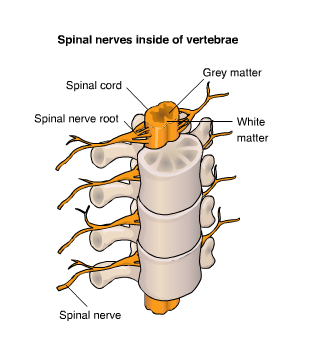
The spinal cord
The second part of the central nervous system is the spinal cord. The spinal cord extends down the vertebral canal to the first lumbar vertebra, and links the brain to many other parts of the body.
A cross-section of the spinal cord reveals an H-shaped internal core of grey matter surrounded by a larger area of white matter. The functions of the spinal cord are:
- to conduct sensory impulses (or afferent impulses) from the periphery of the body upwards to the brain
- to conduct motor impulses (or efferent impulses) from the brain down to the nerves that supply muscles and glands
- to stimulate reflex actions. These are activities in which sensory impulses entering the cord are co-ordinated with motor messages leaving the cord without involving the higher centres of the brain.
